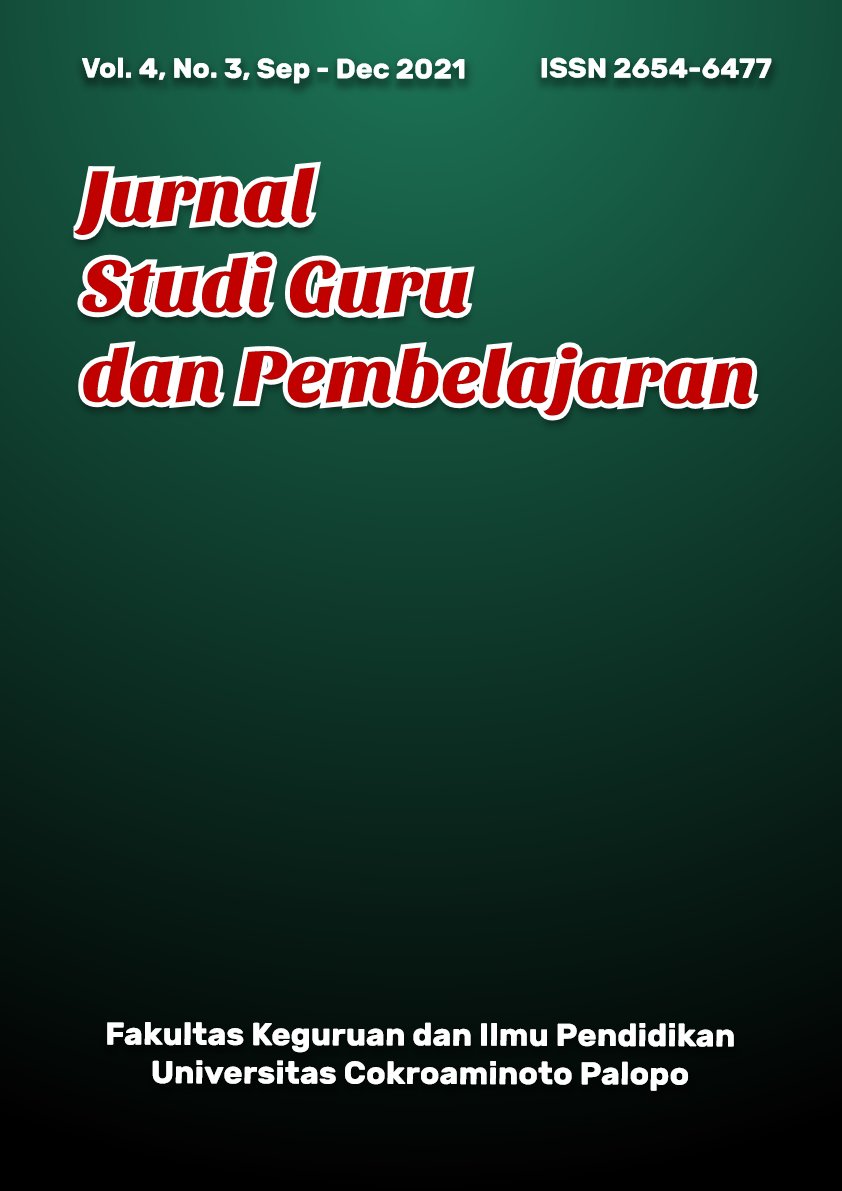Strength and Weakness of Oxford English Textbook “Aim High 5” by Susan Iannuzzi and Paul Kelly Based on the 2013 Curriculum
DOI:
https://doi.org/10.30605/jsgp.4.3.2021.1461Keywords:
Oxford English Textbook, 2013 CurriculumAbstract
This descriptive qualitative research aimed to know the strength and weakness of Oxford English Textbook “Aim High 5” By Susan Iannuzzi and Paul Kelly Based on the 2013 Curriculum. The data sources are the 2013 Curriculum, syllabus, scientific approach, Aim High 5. The resources are analyzed, examined, and explored. The results show that the scientific approach method, one of the teaching methods in the 2013 Curriculum, is found in every unit of the reading text. Moreover, the reading texts are presented in systematic way, it can be seen from all the sections in reading texts. There are 4 subtopic steps or activities in reading sections: 1). Before reading, 2). Read, 3). Understanding ideas, and 4). Vocabulary. It seems that the authors prepare the textbook well, which can be seen from the connectivity of the material, extended exercise, interesting story in every reading text. On the contrary, the weakness of “Aim High 5” Based on the 2013 Curriculum including the steps of reading sections, which are a bit monotone. It can be seen that all units, from unit 1 to 10 has the same steps such as before reading, read, understanding ideas, vocabulary. Moreover, many of vocabularies are unfamiliar, that rarely heard by some of the students especially the students who live in countryside or village, and the students who do not have access to internet and library. Likewise, structure or sentences are sometime little bit difficult to understand by them. It is because the English is the foreigner language in Indonesia, so the knowledge of the English is limited according to some area in Indonesia.
Downloads
References
Banister, P., Bunn, G., & Burman, E. (2011). Qualitative methods in psychology: A research guide: A research guide. McGraw-Hill Education (UK).
Bravmann, S. L., Green, N. S., Joseph, P. B., Mikel, E. R., & Windschitl, M. A. (2000). Cultures of Curriculum. Mahwah, NJ: Lawrence Erlbaum Associates.
Byrd, P. (2001). Textbooks: Evaluation for selection and analysis for implementation. Teaching English as a Second or Foreign Language, 3, 415–428.
Coracini, M. J. (2014). Between acquiring and learning a language: subjectivity and polyphony. Bakhtiniana: Revista de Estudos Do Discurso, 9, 4–24. DOI: https://doi.org/10.1590/S2176-45732014000200002
Creswell, J. W., & Clark, V. L. P. (2017). Designing and conducting mixed methods research. Sage publications.
Denzin, N. K., & Lincoln, Y. S. (2008). Introduction: The discipline and practice of qualitative research.
Elo, S., & Kyngäs, H. (2008). The qualitative content analysis process. Journal of Advanced Nursing, 62(1), 107–115. DOI: https://doi.org/10.1111/j.1365-2648.2007.04569.x
Fraser, S. P., & Bosanquet, A. M. (2006). The curriculum? Thats just a unit outline, isnt it? Studies in Higher Education, 31(03), 269–284. DOI: https://doi.org/10.1080/03075070600680521
Garinger, D. (2002). Textbook selection for the ESL classroom. Center for Applied Linguistics Digest, 2(10).
Herdiansyah, H. (2010). Metodologi penelitian kualitatif untuk ilmu-ilmu sosial. Salemba Humanika.
Hsieh, H.-F., & Shannon, S. E. (2005). Three approaches to qualitative content analysis. Qualitative Health Research, 15(9), 1277–1288. DOI: https://doi.org/10.1177/1049732305276687
Jaroongkhongdach, W., Watson Todd, R., Hall, D., & Keyuravong, S. (2011). Current research topics and methods in Thai and international research articles in ELT. Expanding Horizons in English Language and Literary Studies. DOI: https://doi.org/10.1016/j.jeap.2012.04.006
Komara, E. (2017). Curriculum and civic education teaching in Indonesia. EDUCARE, 10(1).
Macalister, J., & Nation, I. S. P. (2019). Language curriculum design. Routledge. DOI: https://doi.org/10.4324/9780429203763
Mason, J. (2017). Qualitative researching. sage.
Mayring, P. (2007). On generalization in qualitatively oriented research. Forum Qualitative Sozialforschung/Forum: Qualitative Social Research, 8(3).
McDonough, J., & Shaw, C. (2012). Materials and Methods in ELT. John Wiley & Sons.
Osaki, K. M. (2000). Reflection on the change processes implied in the teacher education master plan in Tanzania. Practices and Possibilities in Teacher Education in Africa: Perspectives from Tanzania. Ecoprint: Dar Es Salaam.
Richards, J. C. (2001a). Curriculum development in language teaching. Ernst Klett Sprachen. DOI: https://doi.org/10.1017/CBO9780511667220
Richards, J. C. (2001b). The role of textbooks in a language program. Cambridge University Press Cambridge, UK.
Shank, G. D., & others. (2006). Qualitative research: A personal skills approach.
Sukmadinata, N. S., & others. (2002). Pengembangan kurikulum teori dan praktek.
Downloads
Published
How to Cite
Issue
Section
License
In submitting the manuscript to the journal, the authors certify that:
- They are authorized by their co-authors to enter into these arrangements.
- The work described has not been formally published before, except in the form of an abstract or as part of a published lecture, review, thesis, or overlay journal.
- That it is not under consideration for publication elsewhere,
- That its publication has been approved by all the author(s) and by the responsible authorities – tacitly or explicitly – of the institutes where the work has been carried out.
- They secure the right to reproduce any material that has already been published or copyrighted elsewhere.
- They agree to the following license and copyright agreement.
License and Copyright Agreement
Authors who publish with JSGP agree to the following terms:
- Authors retain copyright and grant the journal right of first publication with the work simultaneously licensed under Creative Commons Attribution License (CC BY-SA 4.0) that allows others to share the work with an acknowledgement of the work's authorship and initial publication in this journal.
- Authors are able to enter into separate, additional contractual arrangements for the non-exclusive distribution of the journal's published version of the work (e.g., post it to an institutional repository or publish it in a book), with an acknowledgement of its initial publication in this journal.
- Authors are permitted and encouraged to post their work online (e.g., in institutional repositories or on their website) prior to and during the submission process, as it can lead to productive exchanges, as well as earlier and greater citation of published work.














